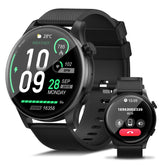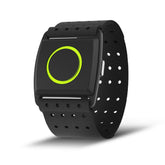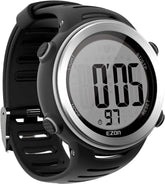10K Training for Beginners: Step - by - Step with Step Count and Heart Rate
Embark on your 10K journey with a science-backed approach using step count and heart rate data—no guesswork required. This beginner’s guide breaks down training phases, weekly plans, and form optimization, all guided by wearable tech to build stamina, prevent injury, and cross the 10K finish line with confidence.
1. Pre-Training Prep: Setting Your Foundation
A. Gear Essentials (No Fancy Equipment Needed)
- Running Shoes: Cushioned models for beginners (e.g., neutral shoes with 8–10mm heel drop).
-
Wearable Tech:
- Step Count Watch: Track daily steps (aim for 5,000–7,000 steps on rest days).
- Heart Rate Monitor: Monitor intensity during runs (opt for wrist-based or chest strap).
B. Fitness Baseline Testing
-
1-Mile Time Trial:
- Jog 1 mile at comfortable pace, record time to set initial fitness benchmark.
-
Heart Rate Zones Calculation:
- Estimate max heart rate (MHR) = 220 - age, then define zones:
- Zone 2 (endurance): 60–70% MHR
- Zone 3 (tempo): 70–80% MHR
- Estimate max heart rate (MHR) = 220 - age, then define zones:
2. 8-Week Step-by-Step Training Plan
A. Weekly Structure (Beginner-Friendly)
| Week | Focus | Step Goal | Heart Rate Target | Workout Example |
|---|---|---|---|---|
| 1–2 | Walk-Run Intervals | 8,000 steps/day | 60–65% MHR | 30 min: 1 min run + 2 min walk x 10 |
| 3–4 | Steady Pace Endurance | 10,000 steps/day | 65–70% MHR | 40 min: continuous easy run |
| 5–6 | Tempo Intervals | 12,000 steps/day | 70–75% MHR | 4x8 min run @ Zone 3 + 2 min rest |
| 7–8 | Race Simulation | 15,000 steps/day | 70–80% MHR | 10K distance at race-pace effort |
3. Step Count: The Secret to Gradual Progression
A. Step Loading Principles
- 10% Rule: Increase weekly step count by ≤10% to avoid overuse injuries.
-
Daily Step Breakdown:
- Run days: 30–40% of daily steps from running
- Rest days: Maintain 5,000+ steps via walking
B. Step Count Watch Tips
- Pedometer Accuracy: Calibrate watch by walking 100m, count steps vs. watch reading (adjust settings if off by >5%).
- Mid-Run Step Alerts: Set vibrations for every 1,000 running steps to maintain consistent cadence (aim for 170–180 steps/min).
4. Heart Rate Training: Avoid Overtraining as a Beginner
A. Zone Training for 10K Success
- Easy Runs (Zone 2): 60–70% MHR, 60–70% of weekly training—build aerobic base.
- Tempo Runs (Zone 3): 70–80% MHR, 20–30% of weekly training—improve lactate threshold.
B. Heart Rate Monitor Insights
-
Post-Run Recovery Check:
- 1 min after stopping, heart rate should drop to <90 BPM—slow recovery signals fatigue.
-
Morning HRV Check:
- Use HRV data to adjust training: if HRV drops >10%, swap hard run for rest or walk.
5. Running Form Optimization with Data
A. Form Metrics to Track
- Cadence: 170–180 steps/min (use step count watch to increase by 5 steps/min weekly).
- Ground Contact Time: <250ms—shorter contact = more efficient running.
B. Form Drills for Beginners
- High Knees: 3x15 reps, focus on quick foot turnover.
- Cadence Drills: Run to a metronome set at 180 beats/min, guided by watch timer.
6. Nutrition & Recovery for Beginner Runners
A. Pre-Run Fueling
- 1–2 Hours Before: 30–50g carbs (e.g., banana + toast), avoid high-fat foods.
- 15 Minutes Before: 10–15g simple carbs (e.g., energy gel) to boost glycogen.
B. Post-Run Recovery Protocol
- 30-Minute Window: 20g protein + 40g carbs (e.g., chocolate milk) to repair muscles.
- Active Recovery Days: Light cross-training (swimming/biking) at <60% MHR, 5,000 steps max.
7. Common Beginner Mistakes & Solutions
-
Overtraining by Distance:
- Solution: Track steps, not just miles—excessive distance leads to burnout.
-
Ignoring Heart Rate Signals:
- Solution: If HR exceeds zone by 5% for >10 min, slow down or walk to recover.
-
Inconsistent Rest Days:
- Solution: Schedule 2–3 rest days/week, use step count watch to ensure low activity.
8. FAQs: 10K Training for Beginners
Q: How many days a week should I train for a 10K?
- 3–4 days/week: 2–3 runs + 1 cross-training session. Rest days are critical for injury prevention.
Q: Can I use a basic fitness tracker instead of a heart rate watch?
- Yes, but heart rate zones and step cadence tracking improve training precision. A dedicated step count and heart rate watch accelerates progress.
Q: What’s the ideal step count for a 10K race?
- Varies by stride length, but ~12,000–15,000 steps for most runners. Practice with your watch to know your race-step target.
Cross the Finish Line with Confidence
Training for a 10K as a beginner is about consistency, not intensity. By using step count to build gradually and heart rate to manage effort, you’ll avoid injuries and stay motivated. Let data be your coach—track progress, adjust plans, and celebrate every step toward your 10K goal.
Lace up, start slow, and trust the process. The 10K finish line is within reach—now take that first step with purpose.
EZON Watch: Precision Training for Beginner Runners
https://ezonwatch.com
https://ezonwatch.com









